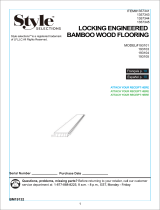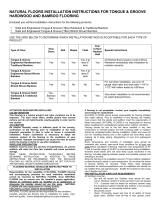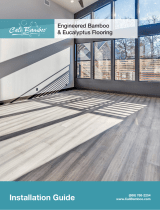
3
Thoroughly examine the flooring prior to installation for grade, color, finish and quality.
Ensure adequate lighting for proper inspection. If flooring is not acceptable, do not install the floor.
Please contact the seller immediately and arrange for replacement. The NWFA states that up to 5%
of material may be culled for blemishes or defects without being considered defective. Please note
our products contain a standard pattern variation and installers should be working from multiple open
boxes to ensure boards are blended throughout. The manufacturer cannot accept responsibility for
installation of flooring with visible defects. Installation of this product warrants the acceptance by the
installer or owner for the quality of the material, as well as conditions in which the material is being
installed therein.
It is the Installer/Owner responsibility to ensure that the conditions are acceptable prior to the installa-
tion of the hardwood floors. The manufacturer declines any and all problems associated with the
hardwood flooring that are related to or attributed to improper jobsite conditions. Any splits, cracks,
grain raising, checking, edge fracturing, splintering, cupping, crowning/peaking, warping, twisting,
expansion/contraction, buckling or chipping that occurs during or after the floor has been installed
and as a result of abuse, misuse, improper maintenance or care, exposure to excessive or insuffi-
cient moisture, improper environmental conditions including excessive heat from radiant heat
systems are not covered under the manufacturer’s warranty. Prior to installation of any flooring, the
installer must ensure that the jobsite and subfloor meet the requirements of these installation instruc-
tions. All necessary accessories, including trim, must be present at the jobsite prior to beginning
installation. The manufacturer is not responsible for flooring failure resulting from unsatisfactory
jobsite and/or subfloor conditions. When purchasing flooring, per NWFA guidelines we recommend
adding 5%-15% to actual square footage needed for cutting allowance and to compensate for culled
material. It is acceptable, per the NWFA guidelines, that up to 5% of material be outside the range of
acceptance.
It shall be the responsibility of the Installer to document installation date, product SKU and Lot infor-
mation, duration of product acclimation, flooring moisture content, subfloor moisture content, site
relative humidity and site temperature. This information must be documented by the installer and a
copy provided to the property owner to ensure product warranty coverage.
TOOLS AND SUPPLIES NEEDED
Moisture Meter, Tape Measure, Pencil, Chalk Line, Hand Saw or Power Saw, Tapping Block, Crow
Bar or Pry Bar, Wood or Plastic Spacers (1/2 in), Hammer or Rubber Mallet, safety glasses, filter
mask, earplugs.
FOR GLUE-DOWN INSTALLATION, YOU WILL ALSO NEED: Premium Wood Flooring Adhesive,
Adhesive trowel (as recommended by adhesive manufacturer)
FOR NAIL-DOWN INSTALLATION, YOU WILL ALSO NEED: Manual or pneumatic 16-gauge floor
nailer OR 16-gauge narrow-crown stapler, 1 3/4 in to 2 in 16-gauge cleats or staples, Finish nailer
and/or finish nails, Nail set, 15 lb. felt or asphalt impregnated Kraft paper, Crow bar or pry bar,
Color-matching wood putty/filler
JOBSITE & PRE-INSTALLATION GUIDELINES
Bamboo flooring should be one of the last items installed for any new construction or remodel proj-
ect. All Bamboo flooring must be installed per the manufacturers and NWFA installation guidelines.
For more information about NWFA guidelines please contact www.NWFA.org .
All “wet” work – i.e. – paint, drywall, concrete, masonry, plumbing must be complete and dry prior
to the delivery of hardwood flooring
Gutters and downspouts should be in place and the exterior grade complete to allow for proper
drainage of water away from the building’s exterior perimeter.















